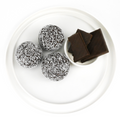Do you see people on social media snapping their lunches of home-cooked soba noodles with avo smash and a microherb garnish – and you’re just trying to find time in your work day to grab a coffee? Sure, it would be great to smash out a big gym workout, prep three clean meals a day and do a daily meditation session. But, when your inbox is flooded, you’re in back-to-back meetings and you’re burning the midnight oil, it’s often just not realistic. Don’t stress: we’ve got three time-efficient tips to help make your day healthier – no microherbs required.
 Make two healthy swaps
Make two healthy swaps
Let’s be realistic – we’re not all going to eat like that wellness warrior we follow on Instagram 24/7. There’s a fair bit of prep time and money that goes in to those kale salads with pomegranate pearls and quinoa risotto with seared tuna. However, setting small achievable goals can make a huge difference to your day-to-day health.
Firstly, aim to have one really healthy meal a day. It doesn’t have to be all zoodles and tofu, either. Just aim for a big serving of vegetables and some lean protein, cooked in healthy fats. Keep it low in carbs to reduce your total carb load for the day. A great option is to swap out any unhealthy take-away work lunches for super clean ones. This means if you end up eating out in the evening, you’ve already nailed your goal for the day. You can grill most proteins and roast veggies a few days in advance. If you can’t be bothered meal prepping, you could also order a bunch of THR1VE meals, plus healthy snacks for the work week. They’re chef-designed and nutritionist-approved, so you won’t get bored.
Secondly, aim to swap out one unhealthy snack a day. Ditch that slice of the office birthday cake, cookie from the work kitchen or chocolate bar from the vending machine. If necessary, swap it for a good source of protein like a serving of nuts, boiled eggs or a lean protein shake. These two healthy swaps can transform your work week, without impacting on your busy day.
HIIT it up
What with early starts and late-night deadlines, it can be difficult to fit in a long gym workout. But do you have 8 minutes to spare? High Intensity Interval Training (HIIT) is the time-poor person’s saviour. A typical Tabata-style program involves 20 seconds of all out work – whether it’s sprints on the beach, in the park, on a stationary bike or in the pool – followed by 10 seconds of recovery. This is repeated 8 times for a total of four minutes. Including a short warm up and cool down, the total workout is just eight minutes. More advanced versions will consist of two or more sequences, but at the most, the work time is only around 12-14 minutes.
The aim here is quality hard work, not quantity. Plus, science suggests a shorter workout is not a even a compromise. Scientists at Canada’s McMaster University found that doing 10 one-minute sprints on a stationary bike with about one minute of rest in between, three times a week, works just as well in improving muscle as hours of conventional less-strenuous biking. Another study in Frontiers in Physiology found it could be an efficient and effective way of cutting the risk of type-2 diabetes.
Bonus: HIIT training can even help boost your brain. New research in the Journal of Cognitive Neuroscience found that people who did short bouts of interval training over just 20 minutes for just six weeks showed significant improvements in high-interference memory. That’s the kind of memory that, say, helps you distinguish your sports bag from another sports bag of a similar brand and colour. The study results were significant because the healthy young adult participants improved in a really short period of time. So, whether you choose to spend 15-20 minutes a day in a Facebook spiral or doing sprints is up to you.
Go fast
Intermittent fasting is the health trend du jour, but don’t worry, you won’t have to starve all day. There’s more ways to fast than just the 5:2 diet. You may be familiar with the five days of regular eating, two days of ultra low-calorie eating model. But an increasingly popular and effective method of intermittent fasting is what’s often referred to as ‘Time Restricted Feeding’ or TRF (we love a health acronym!) Unlike some other types of fasting, you won’t be dozing off by three or getting hangry in your conference calls.
TRF involves restricting the hours in which you eat each day, so you have an extended overnight fast. One easy way is to do this is to skip breakfast and stick to water or black coffee till lunch. Just make sure you get in a healthy, portion-controlled lunch to break the fast (our meal portions are a good guide). A range of studies, particularly from the Salk Institute for Biological Studies, have found that this kind of eating style may help override the harmful effects of a poor diet and stave off diabetes and obesity. As well as its health benefits, it’s a great time-saving solution. Forget the manic morning breakfast prep, you can just dive straight into that to-do list.
The key is to adapt TRF to your lifestyle. If you work out in the morning, then you could just have an early dinner or skip it entirely. You could try it a few times a week or make it a daily routine. So, set a goal for the week to try any one of these time-saving tips and notice the difference to how you look, feel and perform.
THR1VE has a range of healthy ready meals and snacks that can be delivered to your home or office. Enjoy the delicious power of extraordinary health every day! Explore the range here.

 Make two healthy swaps
Make two healthy swaps





















